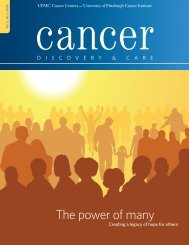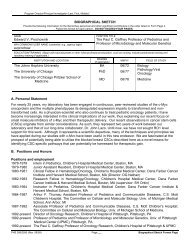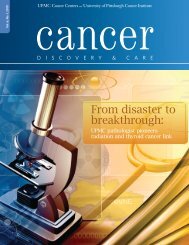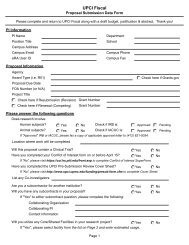Rodent Bedding technical info and Beddinig biblio[3] - University of ...
Rodent Bedding technical info and Beddinig biblio[3] - University of ...
Rodent Bedding technical info and Beddinig biblio[3] - University of ...
You also want an ePaper? Increase the reach of your titles
YUMPU automatically turns print PDFs into web optimized ePapers that Google loves.
Whiteside, TE, Thigpen, JE et al. 2010. Endotoxin, Coliform <strong>and</strong> Dust Level in Various Types <strong>of</strong> <strong>Rodent</strong> <strong>Bedding</strong>. JAALAS 49:184-‐189. -‐Paper bedding types contained significantly less endotoxin than did other bedding types; the highest levels <strong>of</strong> endotoxin were detected in hardwood <strong>and</strong> corncob beddings. Coliform counts varied from less than 10 to 7591 cfu/g in corncob, less than 10 to 137 cfu/g in hardwood beddings, <strong>and</strong> less than 10 cfu/g in paper beddings. Average dust content was less than 0.15% in all commercial bedding types. Zahorsky-‐Reeves, J , <strong>and</strong> Castellani, LW. 2010. Housing Mice on Corncob bedding versus Hardwood Chip may Confound Research Results. AALAS Scientific Session. -‐A variety <strong>of</strong> bedding substrates are commercially available for use in research settings, including hardwood chip, corncob, <strong>and</strong> various paper-‐based beddings. While several studies have been done to assess bedding preference in mice <strong>and</strong> bedding substrates evaluated as far as their effect on the cage microenvironment, little <strong>info</strong>rmation can be found regarding bedding substrate effect on serum glucose levels <strong>and</strong> other indicators <strong>of</strong> metabolism. We compared the serum values <strong>of</strong> glucose <strong>and</strong> triglycerides in C57BL/6J mice (wildtype, WT) <strong>and</strong> mice transgenic for apolipoprotein A-‐II (ApoAII, on a C57BL/6J background) housed on wood chip bedding versus those housed on corncob bedding after a 14-‐h (overnight) fast. Both WT <strong>and</strong> transgenic mice showed significant differences in each serum value based on the type <strong>of</strong> bedding on which they were housed; those mice housed on corncob bedding showed increased blood glucose levels <strong>and</strong> decreased triglyceride levels versus those housed on wood chip bedding. This result demonstrates that bedding material, a variable not <strong>of</strong>ten considered in research, could have pr<strong>of</strong>ound influence on the data for many studies <strong>of</strong> obesity, diabetes, heart disease, or metabolism. Zahorsky-‐Reeves, J. 2011. The Choice <strong>of</strong> <strong>Bedding</strong> Substrate, Route <strong>of</strong> Blood collection, <strong>and</strong> Method <strong>of</strong> Glucose Determination All Affect Fasting Blood Glucose Levels in C57BL/6 Mice. AALAS Platform Session. -‐This study compared 4 bedding substrates (corncob, paper, hardwood chip, <strong>and</strong> wire-‐bottomed cage inserts) <strong>and</strong> 2 routes <strong>of</strong> blood collection(lateral tail vein <strong>and</strong> retroorbital sinus) in 6 male C57BL/6NCrl mice. Mice were maintained with ad libitum food <strong>and</strong> water on each bedding type for 1 wk, with at least 1 wk <strong>of</strong> rest on hardwood chip bedding in between sample collection. The night before blood sampling, the bedding was changed for fresh <strong>and</strong> food removed. Mice were anesthetized with is<strong>of</strong>lurane for all blood sampling. Blood was collected from bothanatomic locations on each mouse up to 5 times over a course <strong>of</strong> 4 mo. Samples collected from the retroorbital sinus were analyzed both by glucometer <strong>and</strong> by chemistry analyzer machine following collection into serum separator tubes. The blood obtained from the tail vein was analyzed for glucose by h<strong>and</strong>-‐held glucometer only. Depending on the bedding provided, each mouse showed variability in the blood glucose values, even when the same bedding type was used at 2 different time points during the study. Significant differences in blood glucose were noted between the 2 collection routes on each testing day when analyzed by the h<strong>and</strong>-‐held glucometer. Variations in glucose levels were also observed when blood obtained from the retroorbital sinus was analyzed using the h<strong>and</strong>-‐held glucometer compared with the machine; these values were not significant across the group, but for some individual mice it approached a 20% difference or more at any one


![Rodent Bedding technical info and Beddinig biblio[3] - University of ...](https://img.yumpu.com/51540189/6/500x640/rodent-bedding-technical-info-and-beddinig-biblio3-university-of-.jpg)







